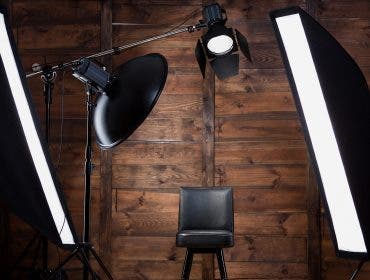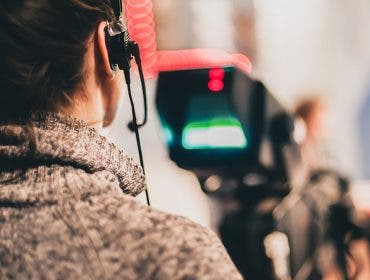Part of a regular Adorama Learning Center series, Sara Landeau’s ‘InSound’ explores the best in audio gear, how-to’s and interviews with other musicians. Read previous installments here.
You can’t take everything you want on tour. Items need to be micro-sized or get traded in for lighter versions. You have to depend on quick tricks and special MacGyver-ing. Early in my touring days I carried way too much, didn’t utilize wheels on gear cases, carried flimsy large guitar cases, and dragged way too much around in heeled shoes through airports. My bandmates in The Julie Ruin, who started touring years before I did (mostly with Bikini Kill and Le Tigre), inspired me with some grid-like proficiency in their carry-ons. During our first tour, Kathleen, the singer, impressed us all by showing us her stage outfit, a leotard-jumpsuit, then scrunched it up in the palm of her hand to fit neatly in a fist, before shoving it into the toe of her packed stage shoes. Just like that! My quest for using limited real estate became an obsession. But this column is about gear, not leotards (although both are equally important in our performance), and as far as Iknow, there are very few pieces of gear that I’m bringing that will fit so neatly in the toe of my Puma.
https://www.instagram.com/p/BFwHiSgx4Dq/?taken-by=thejulieruin
Depending on the length of the tour, or where we’re traveling, I may bring my small pedal board, diminished in size to fit in my square TSA-regulated size carry-on, or the large soft suitcase that slides on top of Tetris-like amps in the tour van. The larger pedalboard is the desired option as it’s hooked up and ready to go as soon as it’s opened. The small one is made of a very light pegboard from Home Depot that’s easy to carry. My friend and I cut it exactly to fit my Muji square carry-on, perfect for smaller European planes. The downside to the pegboard case is that the pedals and patches are not connected and must be reassembled each time before going on stage. I carry a duplicate of every pedal just in case one breaks, including a reverb and vibrato pedal to imitate a Fender Twin Amp, which we rent, should a broken amp disaster occur. This gets heavy and I nearly throw my back out every time I lift it up into the overhead bin. Like a nest of snakes on top of the pedals are dozens of quarter-inch cables, extra patches, an Ispot charger or two; all of which looks on the security camera screen to be what could be misinterpreted as a bomb. I am usually asked by a perturbed security person to show them what is inside. When I start explaining its music gear, they understand right away and give up trying to figure out what I’m actually talking about, close the suitcase, and push me on. Audio jargon can bore some people quickly, so in this case, I use it to my advantage.
https://www.instagram.com/p/6OFYr-R4FD/?taken-by=thejulieruin
Now, musicians deal with the Sophie-esque choice of whether to send a guitar through check-in with the luggage to be brutally tossed around, or risk taking it on the plane and face the issue of it “being too large.” I’ve been told I can’t get on the plane because I was carrying a guitar, and so have many other musicians I know. And what about all those images, videos, TSA lawsuits, and even that youtube parody about the horrors of broken guitar headstocks, smashed, dented, or worse…lost? At least I’m in control if I’m keeping it nearby. So I risk bringing it on in a tightly-fit backpack gig bag, the smallest I can find, with the hopes that having it up against my back, and wearing all black, will disguise the real size. So far this works. And what about normal carry-on items? Since space matters, call it the “KonMari Method” of guitar travel, I bring almost nothing: magazine or soft cover book in the guitar case wrapped around the neck, makeup, aspirin, wallet shoved between the tuning pegs, etc. I’ve had some personal female items fall out of my guitar case after tour that I forgot about. Could be worse, I still have the guitar.
https://www.instagram.com/p/BG20zSLoatj/?taken-by=saralandeau
Anyway, here’s a list of items that are essential for tour:
- high fidelity ear plugs – these cut down the overall volume but keep the frequencies
- duct tape (I go for bright or neon colors, let’s have fun)
- electrical tape (plain black is fine here)
- a high-quality stringwinder and cutter combo
- one good universal power adaptor
- strap locks
- nail clippers
- strings (labeled and color coded for emergency speed)
- white heavy picks (red picks fall on the stage and disappear in the red lights)
- velcro strips for cables
- several packs of nine-volt batteries
- fold-up noise canceling headphones
- On my phone I’ll keep apps handy for tuning
- a metronome to warm up backstage
- a decibel reader
My students have asked me what to do when a string breaks onstage. Stop the song and change it? Isn’t that stressful? The answer is yes, and time-consuming, so let that be the last resort. Bring a second backup guitar, tuned, restrung, and ready to play. Then they ask what if that guitar breaks a string too? Its happened to me so this is whatI do: improvise. I’ll reinterpret the riff or chords in another position and quickly decide how to play the chord a new way. Less is more. But once, in Tasmania, I just went for noise and dissonance, textures and pedal feedback. In the end, the band said they much preferred that solo over the original. Maybe it was the jet lag or just the surreal fact of being in Tasmania that allowed this “better” improv to happen with a broken string. So, who knows? All the prep in the world and your mishaps can be your biggest asset or your best times.






